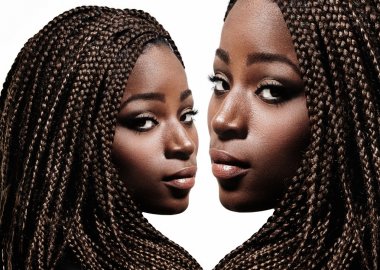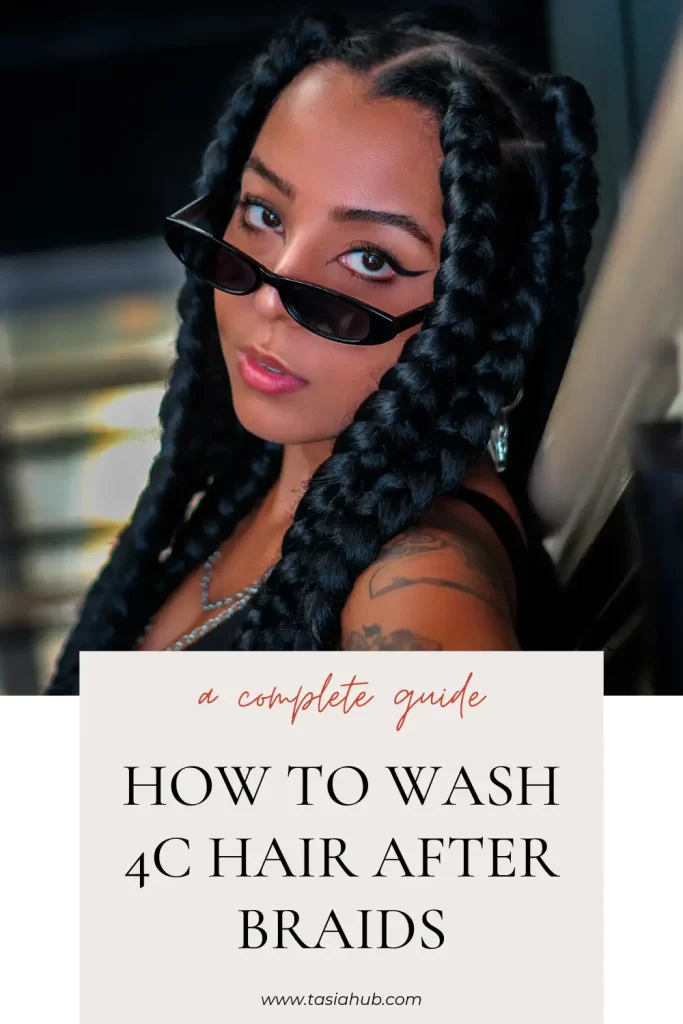A Comprehensive Guide on How to Wash 4C Hair After Braids: Step-by-Step

How To Wash 4C Hair After Braids
Do you have 4C hair and want to know the best way to keep it looking healthy after getting braids?
Everyone knows that taking care of 4C hair requires special attention, and the same holds when it comes to removing braids. From finding the right cleaning products to the correct way to moisturize your hair, there are steps you can take to help maintain the integrity of your hair, without harming it.
This post contains affiliate links and I may earn a small commission when you click on the link at no additional cost to you. As an Amazon Affiliate, I earn from qualifying purchases, thank you.
While braids can be a fantastic way to give your natural hair a break and promote growth, it’s crucial to follow a proper washing routine to ensure your hair remains strong and vibrant. In this step-by-step guide, we’ll walk you through the process of washing 4C hair after braids to help you maintain a healthy and flourishing mane.
From creating your post-braid hair regimen to caring for your scalp, you’ll find the essential tips and tricks you need to keep your hair looking and feeling its best.

How To Wash 4C Hair After Braids Step-By-Step
Taking care of your 4C hair after removing braids is crucial to maintain its health and prevent breakage. The process involves thorough cleansing, conditioning, and detangling to address any knots or tangles that may have formed during the protective style. Here’s a step-by-step guide on how to wash your 4C hair after braids:
Step 1: Prepare Your Washing Tools
Before you begin the washing process, gather the following items:
- Wide-tooth comb or detangling brush
- Sulfate-free shampoo
- Moisturizing conditioner
- Leave-in conditioner
- Towel or T-shirt for drying
- Natural oil or hair butter (optional)
Step 2: Preparing Your Hair
Before jumping into the washing process, it’s essential to prepare your hair. Begin by gently detangling your braided hair using your fingers or a wide-tooth comb. This helps to remove any shed hair and prevents unnecessary breakage during the washing process. Take your time and be patient to avoid causing stress to your hair strands.
Step 3: Sectioning Your Hair
4C hair can be densely packed, making it crucial to section your hair to ensure every strand gets the attention it needs. Divide your hair into manageable sections using hair clips or hair ties. This will make the washing process more efficient and prevent tangling.
Step 4: Pre-Poo Treatment (Optional):
Consider applying a pre-poo treatment before washing to add moisture and make detangling easier. You can use a natural oil or a conditioner with slip. Apply the treatment to each section, focusing on the ends and areas prone to tangles.
Step 5: Diluting Shampoo for Gentle Cleansing
To prevent excessive drying of your hair, consider diluting your shampoo with water before application. This ensures a gentler cleanse while still effectively removing buildup and impurities. Concentrate on massaging the diluted shampoo into your scalp and along the length of your braids.
Step 6: Shampooing:
Apply a moisturizing and sulfate-free shampoo directly to your scalp. Gently massage the shampoo into your scalp using your fingertips, focusing on the roots where product buildup and dirt may accumulate. Be cautious not to rub too hard, as 4C hair can be fragile.
Step 7: Rinsing Your Hair
Thoroughly rinse your hair with lukewarm water. Ensure that all shampoo is washed out, and pay extra attention to the roots and scalp to prevent residue buildup. Remember to keep the water temperature moderate, as hot water can strip your hair of its natural oils.
Step 8: Conditioning
Apply a moisturizing conditioner to your hair, concentrating on the lengths and ends. Use a wide-tooth comb to distribute the conditioner evenly and further detangle your hair. Allow the conditioner to sit for a few minutes before rinsing it out with cool water.
Step 9: Deep Conditioning (optional)
Consider using a deep conditioning treatment to provide extra moisture and nourishment to your 4C hair. Follow the instructions on the product, and if possible, use heat (a hooded dryer or a plastic cap) to enhance the deep conditioning process.
Step 10: Final Rinse with Cold Water
Finish the washing process with a final rinse using cold water. Cold water helps to seal the hair cuticle, promoting shine and locking in moisture. It also reduces frizz and enhances the overall health of your 4C hair.
Step 11: Patting Your Hair Dry
Gently pat your hair dry with a soft, microfiber towel. Avoid rubbing vigorously, as this can lead to breakage and frizz. Be patient and take your time to absorb excess water from your hair.
Step 12: Moisturizing and Sealing
Apply a leave-in conditioner or use the LOC method to seal in moisture for days, focusing on each section. Follow this with a natural oil like coconut oil or jojoba oil to seal in moisture. This step is crucial for maintaining hydration and preventing your hair from becoming dry and brittle.
Step 13: Protective Styling (Optional):
Consider protective styling, such as braids or twists, to minimize manipulation and protect your 4C hair as it recovers from the braiding process.
Tips:
- Be patient and gentle throughout the process to avoid unnecessary breakage.
- Listen to your hair and adjust products and techniques based on its specific needs.
- Moisturize and nourish your hair regularly to maintain its health between styling sessions.
By following this comprehensive guide, you can ensure that your 4C hair receives the care it needs after braids, leaving it cleansed, moisturized, and ready for your next styling adventure.
How Often Should You Wash 4C Hair In Braids?
Caring for 4C hair in braids involves striking a balance between maintaining cleanliness and preserving natural moisture. Washing your hair too frequently can lead to dryness and breakage, while infrequent washing may result in an unhealthy buildup of product and dirt.
In this section, we’ll explore the factors influencing how often you should wash 4C hair in braids to help you achieve a healthy and flourishing mane.
1. Consider Your Scalp’s Condition:
- Dry Scalp: If you tend to have a dry scalp, washing your hair less frequently may be beneficial. Washing too often can strip your scalp of natural oils, leading to increased dryness and potential discomfort.
- Oily Scalp: On the other hand, individuals with oily scalps may find it necessary to wash more frequently to control excess oil production. Pay attention to your scalp’s needs and adjust your washing frequency accordingly.
2. Activity Level and Lifestyle:
- Active Lifestyle: If you engage in regular physical activities that induce sweating, such as exercise, you may need to wash your hair more often to remove sweat and prevent odor. Consider using a dry shampoo between washes to refresh your scalp without a full wash.
- Low Activity Level: If you lead a less active lifestyle, you may be able to extend the time between washes. Be mindful of the accumulation of dirt and product residue, and adjust your washing routine based on these factors.
3. Braid Style and Maintenance:
- Tightness of Braids: Tight braids can contribute to a faster buildup of dirt and sweat. If your braids are tight, you might need to wash your hair more frequently to prevent scalp issues and maintain overall hair health.
- Loose Braids or Twists: If your braids are on the looser side, you may be able to stretch the time between washes. However, it’s essential to monitor your scalp for any signs of itching or discomfort.
4. Climate and Environmental Factors:
- Humidity: In humid climates, 4C hair may be more prone to frizz and product buildup. Adjust your washing frequency based on the climate, opting for more frequent washes in humid conditions.
- Dry Climate: In drier climates, you might be able to go longer between washes. However, be mindful of the potential for dryness, and maintain a consistent moisturizing routine.
5. Personal Hair Goals:
- Growth and Health: If your primary goal is to promote hair growth and maintain optimal hair health, a balanced washing routine is crucial. Overwashing or underwashing can hinder your hair’s growth potential.
- Style Maintenance: If you’re aiming to preserve a particular braided style for an extended period, a less frequent washing schedule may be preferable to maintain the integrity of your chosen style.
Determining how often to wash 4C hair in braids is a personal journey that depends on various factors. Pay attention to your scalp’s needs, lifestyle, and the specific conditions you are in.
By finding the right balance, you can keep your 4C hair in braids clean, healthy, and vibrant. Adjust your washing routine as needed and remember that maintaining a consistent and gentle care routine is key to achieving the best results for your unique hair type.
Conclusion
Washing 4C hair after braids requires a delicate balance of cleansing and moisturizing. By following this step-by-step guide, you’ll be able to maintain the health and vitality of your natural hair, ensuring that it thrives and grows beautifully. Remember to be gentle, patient, and consistent in your hair care routine to achieve the best results for your 4C hair after braids.
This is a simple yet effective method on how to wash 4C hair after braids, so the next time you take down your braids, come back to this guide.
